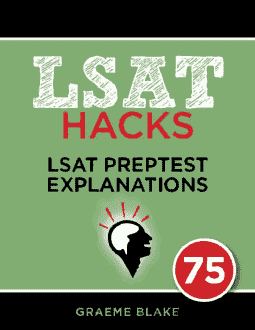QUESTION TEXT: Consumer advocate: Manufacturers of children's toys of…
QUESTION TYPE: Flawed Reasoning
CONCLUSION: Manufacturers of children’s toys shouldn’t overstate dangers on warning labels.
REASONING: Manufacturers should overstate dangers only if this reduces the chance of injuries.
Manufacturers overstate dangers in order to protect against lawsuits.
ANALYSIS: This argument mixes up the reasons for actions and the effects of actions.
Sure, manufacturers are only overstating dangers to protect themselves. However, it’s possible that overstating dangers nonetheless has the effect of making toys safer. In which case overstatement is fine.
___________
- This is a different flaw. Reversing conditions will be pretty obvious when it happens.
Example of flaw: You should overstate dangers only if it reduces injuries. So if you reduced injuries, you must have overstated the dangers. - The author is saying that it’s bad to overstate dangers unless this reduces injuries. This claim can stand on its own.
Regular warning don’t have to be perfect in order for the author’s claim to be true. Claims are rarely linked like this. - Unrepresentative sampling is a different flaw.
Example of flaw: Billy the bonehead and Amber the arsonist both did dangerous things with our toys. So all children will do dangerous things with our toys. - The author didn’t say this! The author said not to overstate dangers unless doing so reduces injuries.That implies that it is possible for a warning to reduce injuries, if manufacturers had different motives. So since this answer didn’t happen, it can’t be the flaw.
- CORRECT. It’s possible for actions to have multiple effects. Overstated labels could reduce the chance of lawsuits but also have the unintended effect of reducing injuries.

Free Logical Reasoning lesson
Get a free sample of the Logical Reasoning Mastery Seminar. Learn tips for solving LR questions


I got this question right but I would like to know if this flaw type is an exclusivity flaw? Thanks!
Yes, I would say so. If exclusivity flaw is defined as inappropriately excluding other options, then that is exactly what the correct answer describes.
Note: This is an old comment but I wanted to clarify the point.
Although I agree that answer E is the correct answer and the reasoning is sound, I disagree with the explanation for choice D. The consumer advocate was saying the if A (overstating dangers) —> B (must reduce injuries). The conclusion was -A, which would rely on the assumption of -B (contrapositive). At first glance that would appear to be the answer stated in choice D. Upon further examination though, you can see that the reason it is incorrect is due to the word “‘prevent’ injuries”. The author never said that the warning label must PREVENT injuries, rather to REDUCE them. As such, the reason D is wrong is because of its use of language that is indeed too strong for the argument.
You’re right in your initial setup, but:
(1) To prevent injuries is to reduce the overall number of injuries brought about by a product.
(2) The clearest reason this answer choice is wrong is that nowhere in the stimulus does the author say that the warning will fail to prevent/reduce injuries. The author is just saying that the intention isn’t to decrease the total number of injuries.